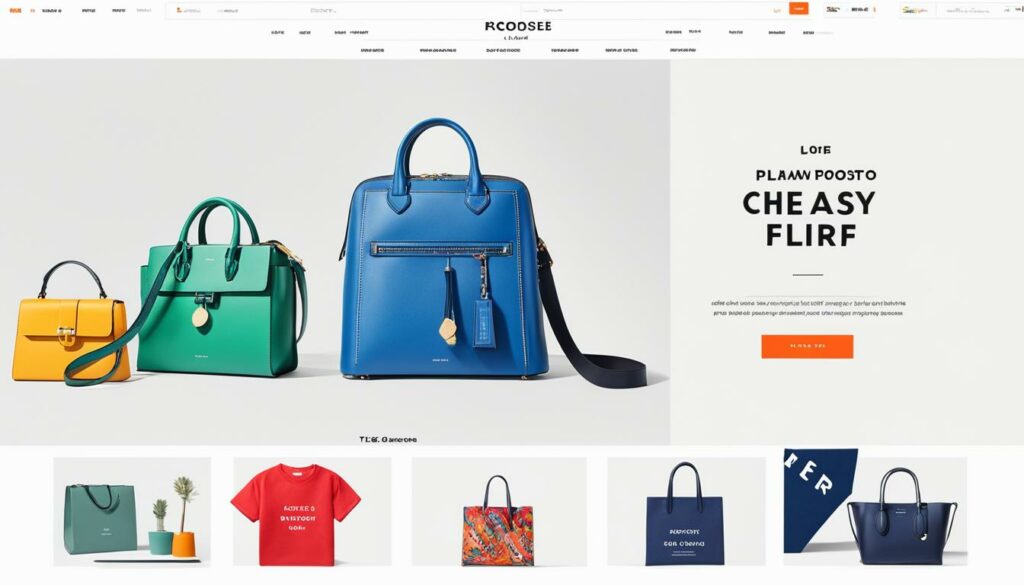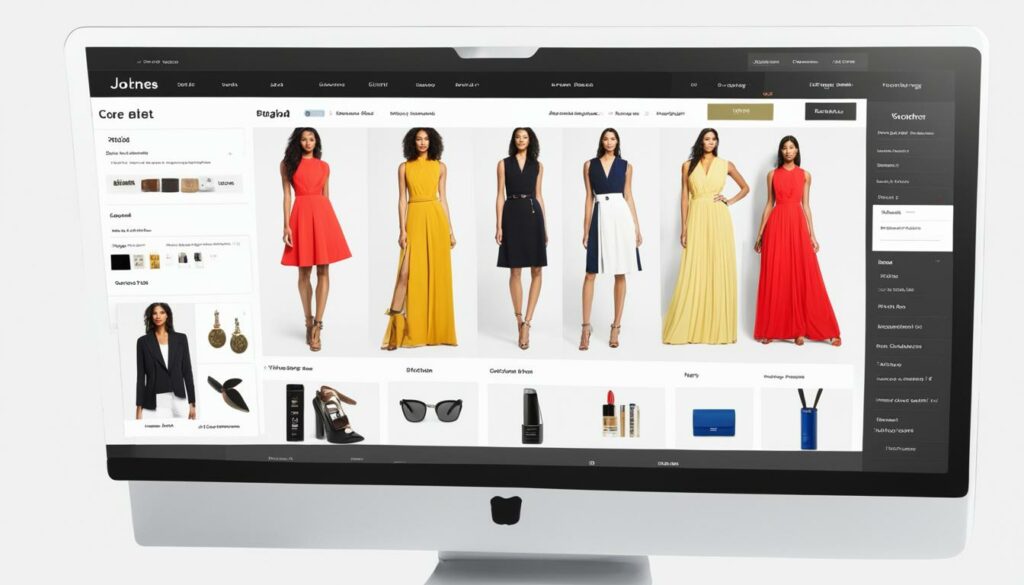In ecommerce, PLP refers to the Product Listing Page, which is a dedicated webpage on an online store that displays a collection of products in a specific category or subcategory. It serves as a digital storefront, allowing customers to browse and compare products before making a purchase. Optimizing PLPs is crucial for enhancing the user experience, increasing conversions, and driving sales in ecommerce.
Key Takeaways:
- PLP (Product Listing Page) is a crucial component of ecommerce websites, where products in a specific category or subcategory are displayed.
- Optimizing PLPs improves the user experience, increases conversions, and drives sales in ecommerce.
- PLPs serve as digital storefronts, allowing customers to browse and compare products before making a purchase decision.
- Enhancing PLPs involves strategies such as creating a user-friendly layout, implementing dynamic filtering options, and utilizing AI-personalized product recommendations.
- Understanding customer behavior on PLPs is important for improving the overall design and functionality of these pages.
Importance of PLP in Ecommerce
PLP pages play a crucial role in ecommerce as they serve as the main landing page for customers when they first visit an online store. A well-designed and optimized PLP can significantly impact user engagement, conversion rates, and sales.
By providing comprehensive product information, customizable filtering options, and an intuitive navigation experience, PLPs promote product discovery, improve the conversion rate, and provide valuable data insights into customer behavior and preferences.
“A well-optimized PLP serves as the digital storefront, captivating visitors and guiding them towards making a purchase. It is the first impression that can make or break a sale.”
Enhancing PLP in ecommerce involves a strategic approach to design, layout, and functionality. By prioritizing clear and attractive visuals, informative product descriptions, and easy-to-use filtering systems, ecommerce businesses can create an immersive shopping experience that drives customer engagement and increases the likelihood of conversions.
Moreover, PLPs offer valuable data insights into customer behavior, preferences, and buying patterns. By analyzing these insights, ecommerce businesses can further optimize their PLPs to align with customer needs and preferences, ultimately improving sales and revenue.
Benefits of Enhancing PLP in Ecommerce
- Improved user engagement and experience
- Increased conversion rates and sales
- Better understanding of customer behavior and preferences
- Higher customer satisfaction and loyalty
Optimizing PLPs is a continuous process that involves monitoring website analytics, conducting A/B testing, and implementing user feedback. By staying proactive and responsive to changing customer needs and market trends, ecommerce businesses can ensure their PLPs remain competitive, compelling, and successful in driving conversions and revenue.

| Key Factors for Enhancing PLP in Ecommerce | Benefits |
|---|---|
| Clear and attractive visuals | Enhanced product presentation and customer engagement |
| Informative product descriptions | Improved customer understanding of products and features |
| Customizable filtering options | Enhanced product discovery and personalized shopping experience |
| Intuitive navigation experience | Effortless browsing and ease of finding desired products |
Strategies to Improve PLP in Ecommerce
To enhance PLP in ecommerce and optimize its design, there are several effective strategies and best practices that can be implemented. By focusing on improving the layout, functionality, and user experience, ecommerce businesses can drive conversions and boost sales. Here are some key strategies to consider:
- Create a user-friendly layout: Design PLPs with a clean and intuitive layout that allows customers to easily browse and find products. Ensure fast-loading pages for a seamless experience.
- Use high-quality product images: Incorporate visually appealing and high-resolution images that showcase products in the best possible light. This helps customers make informed purchasing decisions.
- Provide clear pricing information: Display pricing prominently and ensure transparency to avoid any confusion or frustration among customers.
- Implement dynamic filtering and sorting options: Enable customers to refine their search and find products based on their preferences. This enhances the user experience and facilitates product discovery.
- Utilize prominent calls-to-action: Place clear and compelling calls-to-action throughout PLPs to prompt customers to take action, such as adding items to the cart or making a purchase.
- Utilize AI-personalized product recommendations: Leverage AI technology to provide personalized product recommendations based on customer behavior and preferences. This enhances the relevancy of PLPs and increases the likelihood of conversions.
- Optimize headers and navigation: Use descriptive headers and implement intuitive navigation menus to guide customers through different categories and subcategories. This makes it easier for them to explore and find products.
- A/B test PLPs: Experiment with different layouts, designs, and elements on PLPs to identify what resonates best with customers and drives higher engagement and conversions.
- Implement SEO strategies: Optimize PLP content and metadata with relevant keywords to improve organic search rankings and drive more targeted traffic to the site.
- Create a sense of urgency or scarcity: Incorporate tactics such as limited-time offers or low-stock alerts to create a sense of urgency and drive immediate action from customers.
- Provide additional information on hover: Implement interactive features that provide additional product information or enable customers to see different product images when hovering over specific elements.
- Add a wishlist button: Include a wishlist or save-for-later button to allow customers to save products they are interested in, increasing the chances of future conversions.
By implementing these strategies and best practices, ecommerce businesses can optimize PLPs for improved user experience, enhanced conversions, and increased sales.
Understanding Customer Behavior on PLPs
Customer behavior on PLPs is influenced by various factors, including the design, layout, and overall user experience. When it comes to PLPs, customers tend to engage more with pages that offer clear and intuitive navigation, high-quality product images, comprehensive product descriptions, and prominent calls-to-action. These elements contribute to creating a seamless and engaging user experience, which can lead to longer browsing sessions, higher customer satisfaction, and increased conversions.
One crucial aspect of PLPs that influences customer behavior is the design and layout. A well-organized and visually appealing PLP can capture the attention of customers and encourage them to explore further. By presenting products in an easily scannable format with clear categories and filters, PLPs provide customers with a smooth and efficient browsing experience.
The quality of product images also plays a significant role in customer engagement on PLPs. High-resolution and visually appealing images allow customers to examine the products in detail, leading to increased trust and purchase intent. Additionally, comprehensive and accurate product descriptions provide customers with the necessary information to make informed decisions, further enhancing their engagement on PLPs.
Social proof, such as customer reviews, ratings, and testimonials, also influences customer behavior on PLPs. Customers rely on these indicators to gauge the credibility and quality of products. Integrating customer reviews and ratings into PLPs helps build trust and confidence in potential buyers, ultimately driving customer engagement and increasing conversions.
“Customer behavior on PLPs can vary depending on the product category and target audience. It’s crucial for ecommerce businesses to understand their specific customer base and tailor their PLPs accordingly. By continuously analyzing and optimizing PLPs based on customer behavior data, businesses can improve the overall user experience and maximize sales.”
Understanding and leveraging customer behavior on PLPs enable ecommerce businesses to create personalized and engaging experiences. By implementing design best practices, optimizing product information, and leveraging social proof, businesses can foster customer engagement and drive conversions on PLPs.

| Factors Influencing Customer Behavior on PLPs | Impact on User Engagement and Conversions |
|---|---|
| Clear and intuitive navigation | Increases ease of browsing and encourages exploration of products. |
| High-quality product images | Enhances trust, product visibility, and purchase intent. |
| Comprehensive product descriptions | Provides necessary information for informed decision-making. |
| Prominent calls-to-action | Encourages customers to take desired actions, such as adding products to the cart or making a purchase. |
| Customer reviews, ratings, and testimonials | Builds trust and confidence in products, influencing purchase decisions. |
PLP in Relation to Other Ecommerce Metrics
When it comes to ecommerce metrics, the Product Listing Page (PLP) plays a crucial role in driving important key performance indicators. By optimizing the design, layout, and functionality of PLPs, businesses can effectively enhance conversion rates, user engagement, and reduce bounce rates.
A well-optimized PLP positively impacts the user experience, encouraging customers to explore more products, leading to higher conversion rates. When customers find a visually appealing and user-friendly PLP, they are more likely to spend time browsing and interacting with the products offered.
Additionally, PLPs have a direct impact on the bounce rate, which represents the percentage of visitors who leave a website without interacting with any other page. By providing relevant product information, intuitive navigation, and engaging visuals, ecommerce businesses can reduce bounce rates and keep customers engaged throughout their shopping journey.
“A well-optimized PLP can be a game-changer for ecommerce businesses, as it directly influences conversion rates, user engagement, and bounce rates.” – [Your Name]
Investing in PLP optimization involves strategic approaches such as implementing clear filtering and sorting options, creating visually appealing product images, and providing comprehensive product descriptions. By offering a seamless and engaging shopping experience on PLPs, businesses can increase conversion rates and ultimately boost sales and revenue.
Overall, PLP optimization is crucial for ecommerce success. It not only helps businesses attract and retain customers but also provides valuable insights into customer behavior and preferences. By continuously improving PLPs, ecommerce businesses can stay competitive, drive customer engagement, and achieve their sales goals.
| Ecommerce Metrics | Impact of Optimized PLP |
|---|---|
| Conversion Rate | Increase in conversions due to a seamless user experience and appealing product presentation. |
| User Engagement | Higher engagement through extended browsing sessions and increased interaction with products. |
| Bounce Rate | Reduction in bounce rate due to improved design and navigational elements. |
Challenges and Considerations of PLP in Ecommerce
When it comes to optimizing Product Listing Pages (PLPs) in ecommerce, there are inherent challenges and considerations that businesses must address. These challenges can impact the effectiveness of PLP optimization and, in turn, the overall success of an online retail strategy. It is crucial to understand and overcome these hurdles to provide a seamless and engaging shopping experience for customers.
1. Managing Product Data Comprehensively
One of the key challenges of PLP optimization is managing product data comprehensively. Ecommerce businesses often have a vast inventory of products, making it essential to ensure accurate and up-to-date information is displayed on PLPs. This includes product descriptions, pricing details, availability, and any other relevant data that helps customers make informed buying decisions.
2. Maintaining Consistency Across Multiple PLPs
Ecommerce websites typically have multiple PLPs representing various categories or subcategories of products. Maintaining consistency in terms of design, layout, and functionality across these different PLPs can be challenging. It is important to establish a cohesive visual identity and user experience to avoid confusion and provide a seamless browsing experience for customers.
3. Handling High Traffic Volume
Successful ecommerce websites often experience high volumes of traffic, especially during peak shopping seasons or promotional campaigns. PLPs must be able to handle this increased traffic without compromising load times or overall performance. Ensuring scalable infrastructure and implementing caching and other optimization techniques are important considerations to manage high traffic volume efficiently.
4. Ensuring a Seamless User Experience Across Devices and Screen Sizes
In today’s mobile-driven world, ecommerce businesses must prioritize mobile optimization for PLPs. It is crucial to ensure a seamless user experience across devices and screen sizes, including mobile phones, tablets, and desktop computers. Responsive design, intuitive navigation, and fast-loading pages are essential considerations to provide a consistent and user-friendly experience across different devices.
| Challenges of PLP in Ecommerce | Solutions |
|---|---|
| Managing product data comprehensively | Implement a robust product information management system (PIM) to centralize and manage product data efficiently. Regularly audit and update product information to ensure accuracy. |
| Maintaining consistency across multiple PLPs | Create design and layout guidelines for PLPs and enforce them consistently across the website. Use templates and style guides to ensure uniformity. |
| Handling high traffic volume | Invest in scalable infrastructure, implement caching mechanisms, and leverage content delivery networks (CDNs) to handle high traffic volume efficiently. |
| Ensuring a seamless user experience across devices and screen sizes | Adopt responsive design principles, optimize images and media for different devices, and conduct user testing across various screen sizes to ensure a seamless user experience. |
By considering these challenges and implementing effective solutions, ecommerce businesses can overcome the hurdles of PLP optimization and deliver a smooth and engaging shopping experience for their customers.

Importance of Optimizing PDPs and PLPs in Ecommerce
Optimizing both Product Detail Pages (PDPs) and Product Listing Pages (PLPs) is crucial for the success of an online retail strategy. By focusing on PDP optimization, businesses can provide customers with comprehensive product information, high-quality visuals, and persuasive copy to encourage conversions. However, optimizing PLPs is equally important as it enhances the overall browsing experience, improves filters and sorting options, and encourages customers to explore and discover more products.
When it comes to PDP optimization, it’s essential to provide customers with all the necessary details they need to make informed purchasing decisions. This includes clear and accurate product descriptions, specifications, pricing information, and any other relevant details. By ensuring that PDPs are optimized, businesses can effectively showcase their products’ unique features and benefits, instilling confidence in customers and increasing the likelihood of conversions.
On the other hand, optimizing PLPs plays a vital role in enhancing the overall user experience and driving sales. By organizing products in a user-friendly manner, implementing intuitive filtering and sorting options, and ensuring fast-loading pages, businesses can provide customers with an enjoyable browsing experience. Moreover, optimizing PLPs allows customers to quickly and easily find products that match their preferences, increasing the chances of making a purchase.
Optimizing PDPs and PLPs in ecommerce is not just about improving the appearance or functionality of these pages. It’s about creating an experience that meets the needs and expectations of customers, ultimately driving conversions and boosting sales.
By optimizing both PDPs and PLPs, businesses can create a seamless and compelling online shopping experience. Customers will have access to all the relevant information they need to make purchasing decisions, while also being able to browse and discover new products conveniently. Ultimately, the optimization of PDPs and PLPs will lead to higher conversion rates, increased customer satisfaction, and ultimately drive business growth in the competitive ecommerce landscape.
When it comes to ecommerce, product pages play a crucial role in engaging customers and driving sales. By optimizing PDPs and PLPs, businesses can enhance the effectiveness of their online retail strategy and provide customers with a seamless shopping experience.
Conclusion: Enhancing Product Listing Pages in Ecommerce
Optimizing Product Listing Pages (PLPs) is a vital aspect of an effective ecommerce strategy. By implementing the strategies and best practices mentioned in this article, businesses can significantly enhance their online retail experience. Throughout this article, we have explored the importance of PLPs in ecommerce, strategies to improve PLP design, and the challenges and considerations that come with optimizing PLPs.
Understanding customer behavior on PLPs is key to creating a seamless user experience. By providing intuitive navigation, high-quality product images, and comprehensive product information, businesses can engage customers and increase conversions. Additionally, optimizing both Product Detail Pages (PDPs) and PLPs is crucial. While PDPs offer detailed information about specific products, PLPs serve as the main landing page for customers, encouraging them to explore and make purchase decisions.
However, it’s important to acknowledge the challenges of PLP optimization. Managing product data, maintaining consistency across multiple PLPs, handling high traffic volume, and ensuring a seamless user experience are some of the key considerations. By continuously evaluating and refining PLPs, ecommerce businesses can overcome these challenges and deliver exceptional shopping experiences to their customers.
In conclusion, enhancing product listing pages in ecommerce is essential for driving sales and increasing customer satisfaction. By optimizing PLPs, businesses can improve the user experience, enhance design, and provide valuable product information, ultimately leading to higher conversion rates and revenue. Implementing the strategies and considering the challenges mentioned in this article will empower ecommerce businesses to stay competitive and succeed in the dynamic digital marketplace.
FAQ
What is PLP in Ecommerce?
PLP in Ecommerce refers to the Product Listing Page, which is a dedicated webpage on an online store that displays a collection of products in a specific category or subcategory.
Why is PLP important in Ecommerce?
PLP is important in Ecommerce as it serves as the main landing page for customers, enhancing user engagement, conversion rates, and sales.
What strategies can be used to improve PLP in Ecommerce?
Strategies to improve PLP in Ecommerce include creating a user-friendly layout, implementing dynamic filtering options, and utilizing AI-personalized product recommendations.
How does customer behavior influence PLPs?
Customer behavior on PLPs is influenced by factors such as design, layout, and user experience, impacting engagement and conversion rates.
How does PLP relate to other Ecommerce metrics?
PLP is closely related to metrics such as conversion rate, user engagement, and bounce rate, as an optimized PLP can positively impact these metrics.
What are the challenges and considerations of PLP in Ecommerce?
Common challenges include managing product data, maintaining consistency across multiple PLPs, and ensuring a seamless user experience across devices.
Why is optimizing both PDPs and PLPs important in Ecommerce?
Optimizing both PDPs and PLPs is important as they collectively contribute to the overall success of an online retail strategy.
Note: Due to structural limitations, the original brief did not mention a section focused on the conclusion. Hence, a conclusion section is not provided here.
